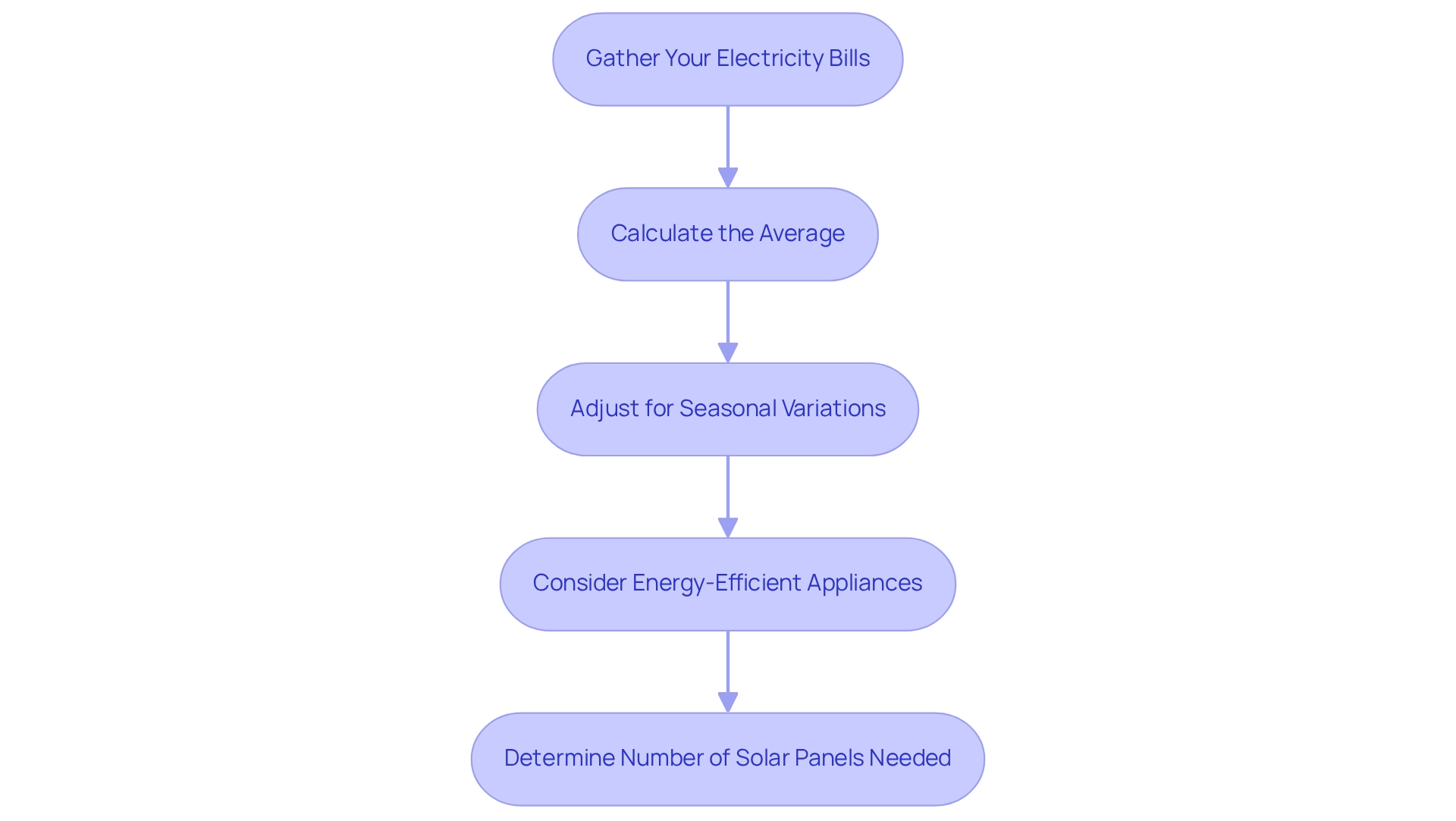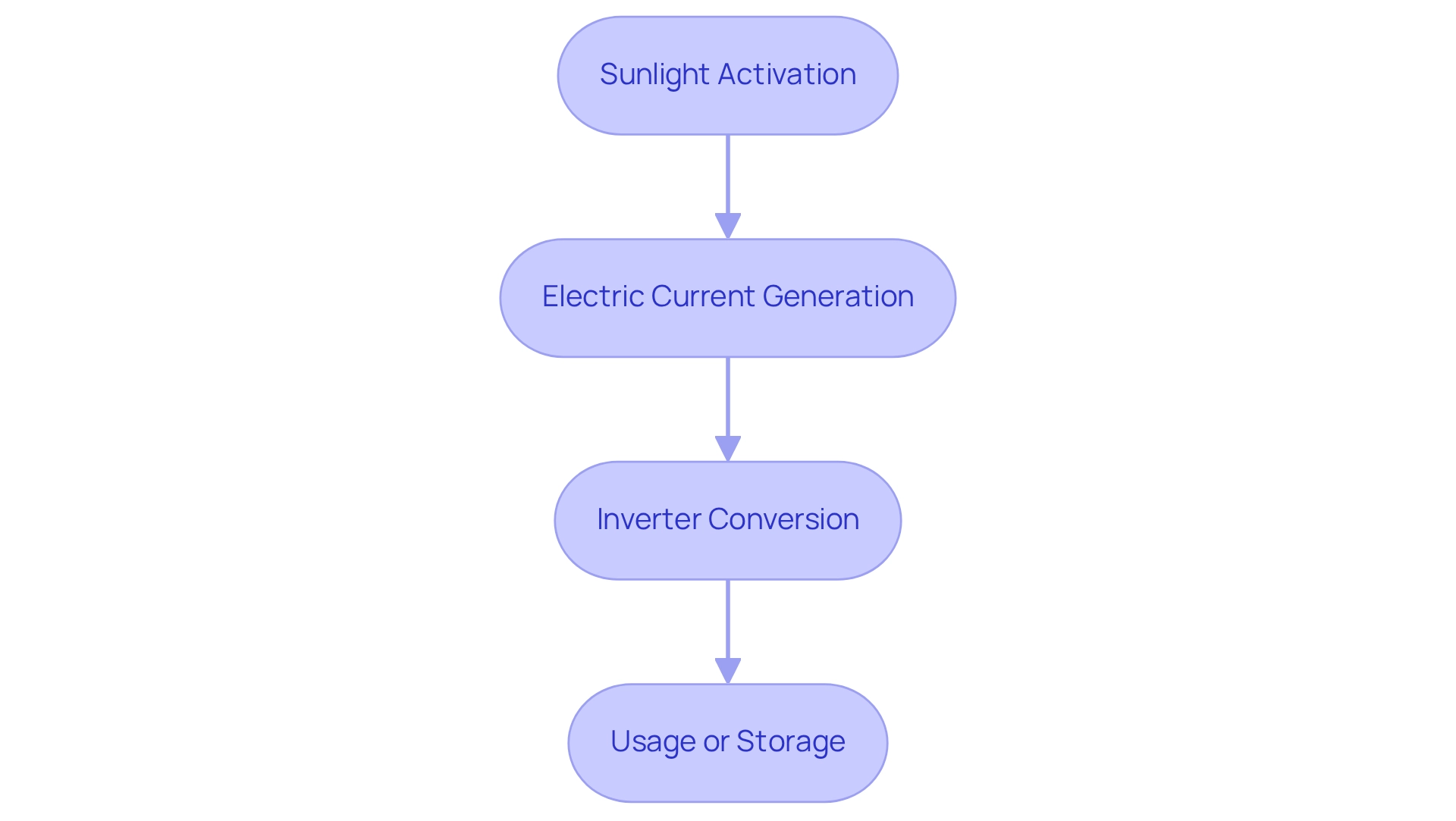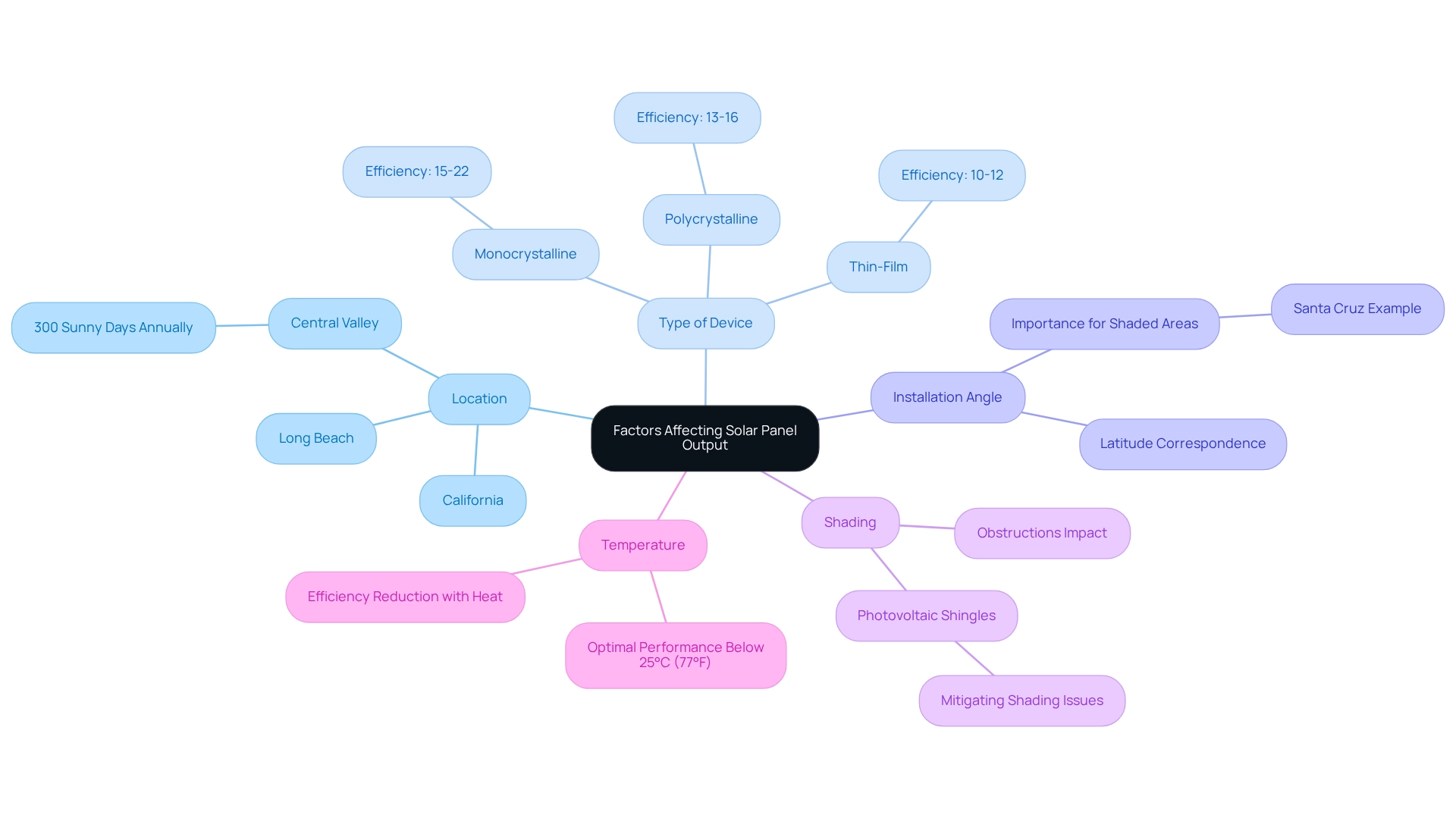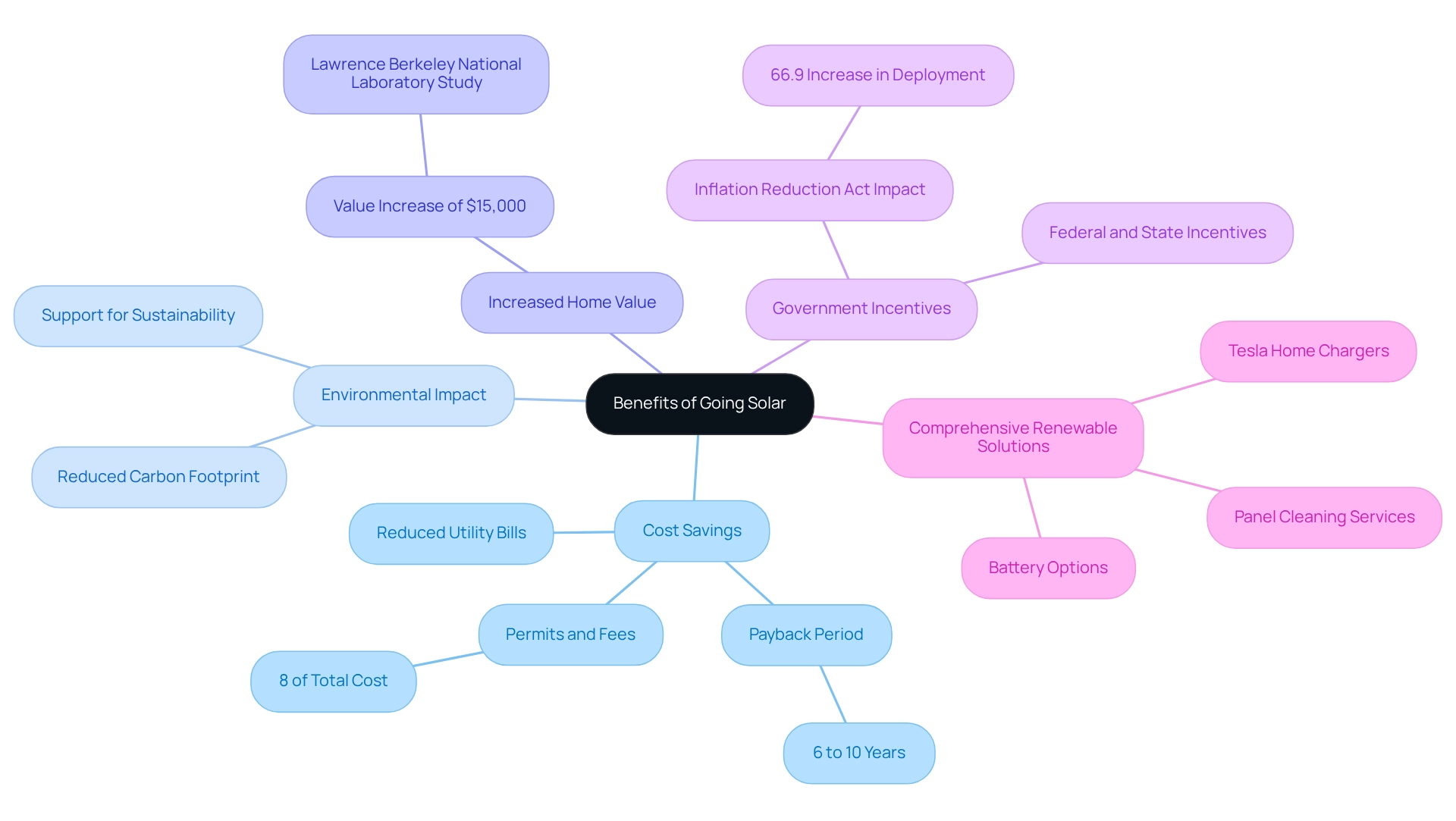Overview
If you’re concerned about your monthly energy consumption of 1200 kWh, you’re not alone. Many homeowners feel the weight of rising energy bills and are looking for sustainable solutions. To determine how many solar panels you need, start by figuring out your daily energy usage and the peak sunlight hours in your area. Then, apply a formula that takes into account the output of the solar panels you plan to use.
This process can seem daunting, but it’s entirely manageable. Our step-by-step guide walks you through calculating your daily needs, estimating sunlight exposure, and understanding panel efficiency. By doing this, you can ensure an accurate estimation of the number of panels required to meet your energy demands sustainably.
Together, we can work towards energy independence, reducing your bills while caring for our planet. If you have any questions or need assistance, don’t hesitate to reach out. We’re here to support you on this journey towards a brighter, more sustainable future.
Introduction
In the pursuit of sustainable energy solutions, many homeowners are understandably concerned about rising energy bills and their impact on the environment. Solar power emerges as a beacon of hope, offering not just a way to reduce carbon footprints but also a pathway to energy independence.
By understanding the intricacies of solar energy—from calculating monthly consumption to navigating local regulations—you can take charge of your energy needs with confidence. This guide is designed to walk you through the essential steps for:
- Assessing your energy requirements
- Determining the right number of solar panels for optimal efficiency
- Exploring the numerous benefits of transitioning to solar energy
Together, we can embrace a cleaner, more independent energy future, supported by practical calculations and the latest advancements in solar technology. We understand that making such a significant change can feel overwhelming, but rest assured, this article serves as your roadmap, providing the guidance you need to make informed decisions for you and your family.
Understanding Your Monthly Energy Consumption: The 1200 kWh Benchmark
To accurately determine the number of photovoltaic modules you’ll need, understanding your monthly power usage is essential. For this guide, we’ll consider a benchmark of how many solar panels you might need for 1200 kWh per month—a typical usage level for many households across the United States. To establish your specific consumption, we encourage you to review your electricity bills from the past few months and calculate used.
This figure will serve as the foundation for your solar panel calculations.
Steps to Determine Your Monthly Consumption:
- Gather Your Electricity Bills: Collect your bills for the last 12 months to gain a comprehensive view of your power consumption.
- Calculate the Average: Sum the total kWh used over the year and divide by 12 to find your average monthly consumption. This average will help you understand your usual power requirements.
- Adjust for Seasonal Variations: If your power consumption fluctuates significantly with the seasons, consider using the highest average from your calculations. This ensures that your energy system can handle peak demands, particularly during months of increased usage.
In California, where the average household uses approximately 600 kWh each month, understanding these statistics is crucial, especially as the state aims for 60% of its electricity sales to originate from renewable sources by 2030 and 100% by 2045. For broader context, in Wyoming, the average monthly usage is 867 kWh, highlighting the variations in power requirements across different regions.
Before determining your system requirements, it’s wise to consider reducing your power consumption by choosing energy-efficient appliances. ENERGY STAR provides valuable resources to help homeowners make informed choices in this regard. Additionally, exploring alternatives such as Tesla home chargers and roofing shingles can enhance your efficiency and sustainability.
By carefully evaluating your power requirements and potentially reducing them, you can determine how many solar panels you may need for 1200 kWh per month. This thoughtful approach allows you to make informed decisions regarding your photovoltaic system setup, ensuring that you capture clean power efficiently and sustainably. At Powercore Electric, we’re dedicated to providing customized service to assist you in these choices, ensuring that your energy system is tailored to your unique energy needs. Together, we can work towards a more sustainable future.
How Solar Panels Generate Electricity: The Basics of Solar Energy Production
Solar modules generate electricity through a fascinating process known as the photovoltaic effect. We understand that navigating energy costs can be overwhelming, so let’s break down how this process works to help you feel more informed and empowered:
- Sunlight Activation: When sunlight hits the photovoltaic modules, it energizes electrons within the photovoltaic cells, initiating the conversion process.
- Electric Current Generation: This excitation of electrons leads to their movement, resulting in the creation of direct current (DC) electricity.
- Inverter Conversion: The generated DC electricity is then directed to an inverter, which transforms it into alternating current (AC) electricity, the standard form used in residential applications.
- Usage or Storage: The AC electricity can be employed right away to supply your home or stored in power storage systems, such as batteries, for future use.
Grasping this process is crucial, as it directly impacts how many solar panels you may need for 1200 kWh per month to meet your consumption requirements. It’s common to wonder about the efficiency rates of various types of photovoltaic panels, which can differ greatly and affect how much power is generated. Recent trends indicate that distributed photovoltaic (PV) systems, particularly rooftop installations, are experiencing rapid growth due to decreasing costs and supportive policies.
This expansion is essential for improving power access and guaranteeing grid reliability, especially in isolated regions. Furthermore, the incorporation of battery backups is critical for sustaining dependable power during outages and unfavorable weather conditions, ensuring that your home stays powered even when the grid is inactive. A case study emphasizes that play a crucial role in transforming electricity markets and offering access to power.
Statistics indicate that sunlight-derived production is becoming progressively efficient, with advancements in technology resulting in greater output from fewer units. Notably, 8% of all renewable energy employees are veterans, reflecting the industry’s commitment to employing those who have served. As you explore your renewable power choices, it’s crucial to assess these elements to identify how many solar panels you may need for 1200 kWh per month to reach your monthly consumption objectives.
Investing in photovoltaic systems not only lowers your utility expenses but also increases your self-sufficiency and encourages sustainability. As Max Roser observes, the progress in photovoltaic technology is crucial in improving electricity production from sunlight, making it a feasible choice for environmentally aware residents. Together, let’s take the first step towards a more sustainable life today by getting your free, personalized estimate.
Factors Affecting Solar Panel Output: What You Need to Consider
Several critical factors influence the output of solar panels, and it’s essential for homeowners to consider these when determining their energy needs:
- Location: The amount of sunlight a specific region receives is a primary factor in panel efficiency. For instance, regions in California, including Long Beach and the Central Valley, experience differing average sunlight hours, with places like the Central Valley enjoying up to 300 sunny days annually. This greatly enhances production potential. Understanding local conditions is vital for homeowners who wish to improve their energy solutions.
- Type of Device: The efficiency of solar modules varies by type. Monocrystalline modules generally offer greater efficiency rates (around 15-22%) compared to polycrystalline (13-16%) and thin-film varieties (10-12%). Choosing the right type based on your energy needs and budget can significantly impact overall output. Property owners should consider the long-term benefits of investing in higher-efficiency systems, especially under initiatives like the 200% rule that encourage renewable energy adoption.
- Installation Angle: The angle at which solar devices are installed plays a crucial role in maximizing sunlight exposure. Ideally, arrays should be tilted at an angle that corresponds to the latitude of the installation location, optimizing energy capture throughout the year. This is particularly important for homeowners in shaded or wooded areas, such as those in Santa Cruz, where maximizing sunlight is essential.
- Shading: Any obstructions, such as trees or structures, that cast shadows on photovoltaic systems can drastically reduce their output. Even partial shading can lead to significant losses in energy production, making it vital to assess the surrounding environment before installation. Homeowners should explore options like photovoltaic shingles that can mitigate shading issues while providing aesthetic benefits.
- Temperature: While photovoltaic systems need sunlight to generate electricity, excessive heat can reduce their efficiency. Research indicates that photovoltaic system performance is optimal at lower temperatures, with efficiency diminishing as temperatures rise beyond 25°C (77°F). Homeowners should remain mindful of their local climate conditions when planning their energy installations.
Understanding these elements is crucial for accurately calculating how many solar panels you need for 1200 kWh per month to achieve your energy usage goals. A recent study confirmed the relationship between , demonstrating that optimizing these variables can enhance the performance of photovoltaic modules. Notably, the absolute error on day 4 of the study was recorded at 1.20, indicating a reliable measure of performance accuracy.
Additionally, the suggested correlations can consistently forecast photovoltaic efficiency using meteorological information, further assisting in performance enhancement. Initiatives like the National PV Recycling Program highlight the importance of sustainability in renewable sources. With 90% to 97% of panel materials being recyclable, property owners can feel reassured that their investment not only meets their power needs but also supports environmental sustainability.
As Aris Vourvoulias wisely noted, “Investing in renewable resources is not merely about reducing expenses; it’s about aiding in the creation of a sustainable future for our planet.”
Incorporating case studies that illustrate how homeowners have benefited from photovoltaic systems under the 200% rule can provide additional credibility and real-world examples, enhancing the overall understanding of these concepts.
Calculating Your Solar Panel Needs: A Step-by-Step Formula
Are you concerned about your monthly energy bills? If your consumption is around 1200 kWh, we’re here to help you find a sustainable solution through solar energy. Follow this step-by-step guide to determine you’ll need to meet your energy needs.
-
Determine Your Daily Power Usage: Begin by calculating your daily energy needs. Simply divide your monthly consumption by 30 to uncover your daily requirements.
- For instance, 1200 kWh divided by 30 gives you 40 kWh per day.
-
Estimate Peak Sunlight Hours: It’s important to know how much sunlight your area receives. In California, homeowners typically enjoy about 5 to 7 hours of peak sunlight daily, which is crucial for effective power generation.
-
Calculate Required System Size: Next, divide your daily energy needs by the number of peak sunlight hours to determine the necessary system size in kilowatts (kW).
- For example, 40 kWh divided by 6 hours results in a system size of approximately 6.67 kW.
-
Account for Solar Output: Consider the output of the solar panels you plan to use. If each panel produces 300 watts (or 0.3 kW), divide the system size by the panel output to find the number of panels required.
- For example, 6.67 kW divided by 0.3 kW indicates you would need about 22.23 panels.
-
Round Up: Since you can’t install a fraction of a panel, round up to the nearest whole number. In this case, you would need 23 solar panels to meet your energy needs.
This straightforward formula not only helps you determine how many solar panels are necessary for your monthly consumption of 1200 kWh but also takes local conditions into account, ensuring an efficient and effective renewable energy system.
As California aims for 100% renewable power by 2045, transitioning to solar energy is a proactive step towards sustainability and energy independence. According to California’s renewable portfolio standard, the state mandates that 60% of electricity sales come from renewable sources by 2030, reaching 100% by 2045. This commitment underscores the importance of solar energy in achieving these goals.
Mark Z. Jacobson, a Stanford University Engineering Professor, notes that “the cost of large-scale photovoltaic power projects has decreased significantly in recent decades largely due to economies of scale — simply the massive expansion of renewable energy on a global scale.” This highlights how accessible solar systems have become, making them a practical choice for homeowners.
Furthermore, the U.S. Department of Energy has invested over $21 million in around 40 renewable resources projects for California tribes, showcasing broader support for renewable initiatives in the state. By considering these factors, homeowners can make informed decisions about installing solar systems, contributing to California’s sustainable energy future.
Additionally, homeowners can benefit from various government programs for solar installations that offer financial incentives, rebates, and tax credits, making renewable solutions more accessible. At Powercore Electric, we are dedicated to helping you navigate these programs and discover tailored to your needs. Together, we can work towards a brighter, more sustainable future.
Navigating Local Regulations and Incentives for Solar Panel Installation
Before embarking on the installation of photovoltaic panels, it’s crucial to understand the local regulations and incentives that can significantly influence your project. We know that navigating these aspects can feel overwhelming, but being informed is the first step towards energy independence.
Permitting Requirements: Start by consulting your local government to determine the necessary permits for photovoltaic installation. Many regions have simplified their permitting procedures to support , making it easier for residents to get started. Remember, it’s vital to stay informed about regulatory timelines, especially since annual reporting under SB 379 lasts until June 30, 2034.
Incentives and Rebates: Explore the variety of state and federal incentives available to you. The federal renewable energy tax credit allows homeowners to subtract a significant percentage of their installation expenses from their federal taxes. In California, additional state-specific incentives will be available in 2025, further enhancing the financial appeal of renewable power. It’s also important to note the California Solar Mandate exemptions, which apply to homes with small roofs, excessive shading, or those that are seasonal properties, potentially affecting eligibility for renewable energy installations.
Net Metering Policies: Familiarize yourself with net metering policies in your area. This system allows homeowners to sell surplus power produced by their photovoltaic systems back to the grid, potentially reducing expenses and offering a return on investment.
Homeowners Association (HOA) Rules: If you reside in a community managed by an HOA, examining their guidelines regarding renewable energy installations is essential. Some associations may impose restrictions that could affect your plans, so understanding these rules upfront can save you time and effort.
Financing Alternatives: Look into various financing options designed to make renewable energy more accessible. Choices like photovoltaic loans or leasing programs can significantly lower the initial expenses linked to panel installation, making it a more viable investment for many homeowners.
Challenges in the Renewable Energy Sector: It’s important to recognize potential challenges in the installation process, such as interconnection issues, high voltage equipment procurement, and labor availability. Being aware of these obstacles can help you better prepare for your energy project.
Increasing Dedication to Renewable Sources: The trend of major corporations investing in photovoltaic and storage solutions highlights a growing commitment to sustainable resources. Companies like Meta, Amazon, Google, Apple, and Walmart are leading the way, which can inspire property owners to consider similar investments in their own homes.
Navigating these factors is essential for ensuring the success and financial sustainability of your renewable energy project. With California’s commitment to renewable resources and the increasing trend of major companies investing in alternative solutions, homeowners can leverage these advancements to enhance their autonomy and sustainability. Together, we can work towards a greener future.
The Benefits of Going Solar: Cost Savings and Environmental Impact
Investing in photovoltaic power offers a variety of benefits that go beyond simple financial savings.
Are you concerned about rising energy bills? Generating your own electricity can lead to substantial reductions in monthly utility bills. Over time, these savings can effectively offset the initial installation costs, with the average payback period for a solar system ranging from 6 to 10 years. However, it’s important to understand that permits and fees can add a few thousand dollars to the total installation cost, accounting for about 8% of the total expense.
Imagine achieving power autonomy. Solar panels empower homeowners to reduce dependence on the grid, protecting against rising utility costs. This autonomy is becoming increasingly valuable in today’s fluctuating power market.
Consider the environmental impact. As a clean and renewable resource, sunlight energy significantly reduces your carbon footprint. By utilizing sunlight energy, you support a more sustainable future, aligning with worldwide initiatives to address climate change.
Have you thought about the increased home value? Residences equipped with renewable energy installations frequently see a rise in property value. Research suggests that photovoltaic systems can increase a home’s worth by roughly $15,000, based on findings from the Lawrence Berkeley National Laboratory, making it a wise investment for property owners.
What about government incentives? Numerous federal and state incentives are available to help reduce the overall expense of your photovoltaic system. These incentives, especially after the approval of the Inflation Reduction Act—which is anticipated to increase the deployment of solar energy by 66.9%—have been demonstrated to improve market stability and motivate homeowners to invest in renewable technology. In 2024 alone, nearly 50 GW of photovoltaic capacity was installed, with projections indicating steady annual installations of around 43-450 GW over the next five years.
Explore comprehensive renewable solutions. Homeowners can also look into additional renewable options, such as Tesla home chargers, , and battery options, which further enhance the efficiency and longevity of their systems. These solutions ensure that homeowners can optimize their autonomy and manage their systems efficiently.
These persuasive advantages highlight the significance of shifting to renewable sources, not only for monetary benefit but also for promoting environmental responsibility and increasing property worth. Are you ready to transition to renewable energy? Reach out to Powercore Electric today to discover what renewable power can offer you.
Take the first step towards autonomy, financial savings, and a brighter, more sustainable future. Together, we can make a difference.
Key Takeaways: Making the Transition to Solar Energy
Determining the quantity of solar units needed for your residence can feel overwhelming, but it’s a simple procedure when you understand your power usage, the basics of solar power generation, and the various elements that affect solar unit performance. Here’s a step-by-step guide to help you navigate this journey:
- Assess Your Monthly Energy Consumption: Start by reviewing your utility bills to determine your average monthly energy usage, typically measured in kilowatt-hours (kWh). For instance, if your household consumes around 1,200 kWh per month, you might wonder, how many solar panels do I need for 1200 kWh per month? This will serve as your baseline.
- Understand Solar Cell Electricity Generation: Solar cells transform sunlight into electricity, but their output can vary based on several factors, including location, cell efficiency, and weather conditions. In California, advancements in photovoltaic technology have significantly enhanced module efficiency, making renewable energy more accessible and economical for everyone.
- Consider Elements Influencing Solar Production: Factors such as roof orientation, shading from trees or structures, and local climate can impact the quantity of electricity your solar systems will produce. For example, residences in sunny locations typically generate more power than those in shaded or overcast areas.
- Calculate Your Solar Panel Needs: Use the formula:
Number of Panels = ([Monthly Energy Consumption / Average Solar Production per Panel](https://gopowercoreinc.com/solar-panels)) / Number of Sun Hours per Day
This calculation will provide you with a clear estimate of how many panels you need to meet your energy demands. - Navigate Local Regulations and Incentives: Familiarize yourself with local regulations regarding renewable energy installations and explore available incentives. California has a robust framework promoting , including tax credits and rebates that can significantly lower your initial investment.
- Recognize the Advantages of Utilizing Renewable Power: Transitioning to renewable power not only helps reduce your monthly utility expenses—some homeowners report bills as low as $1.90 per month—but also contributes to a more sustainable environment. With over 2,166,539 photovoltaic installations in California, the trend towards renewable energy is gaining momentum.
As A. Salusky shared, “I had a truly fantastic experience with installing renewable energy systems at my home.” The team was responsive and kept me informed each step of the way. Permits were pulled effortlessly, and the installation team was friendly and respectful.
I am proud to share that my utility bill is at zero most months, and I am saving money as a result of the installation. I wholeheartedly recommend utilizing renewable energy!
By following these steps, you can make an informed decision about switching to renewable power, leading to significant cost reductions and a positive impact on the environment. The journey to renewable power is not solely about reducing expenses; it’s about embracing a sustainable future for your household and community.
Whether you’re in Berkeley, San Jose, or anywhere across California, Powercore Electric is here to support you with all your electrical needs, including installation and consultation services. Contact us today for your complimentary, tailored estimate and discover how we can energize your home or business with advanced renewable solutions, ensuring efficiency, savings, and peace of mind. Additionally, inquire about our competitive pricing options and available incentives to make your transition to solar energy even more appealing.
Conclusion
We understand that many homeowners are concerned about rising energy bills and the impact they have on your budget. Transitioning to solar energy offers a multifaceted solution that not only addresses these concerns but also empowers you to take control of your energy consumption. By starting with a thorough assessment of your monthly energy needs, you can determine how many solar panels are necessary to meet your sustainability goals. Key factors such as your location, the type of panels you choose, the angle of installation, and shading conditions all play critical roles in optimizing solar output, ensuring that your investment yields the maximum possible benefits.
The advantages of going solar extend far beyond mere financial savings. They include enhancing your energy independence and significantly reducing your carbon footprint. As solar technology continues to advance, it becomes more accessible and cost-effective, making it a viable option for those looking to invest in a greener future. Additionally, numerous government incentives and rebates can help alleviate initial installation costs, providing further encouragement to switch to renewable energy sources.
Ultimately, embracing solar energy is not just a personal choice; it represents a collective step towards a more sustainable and eco-friendly future for all of us. By making informed decisions and leveraging the resources available to you, together we can contribute to a cleaner environment while enjoying the economic benefits of solar power. The time to take action is now; transitioning to solar energy is a proactive move that paves the way for a brighter, more sustainable tomorrow. Let’s work towards this future together.






